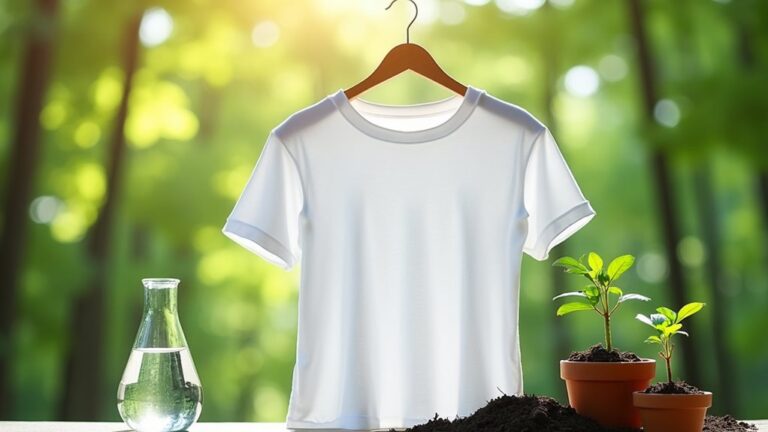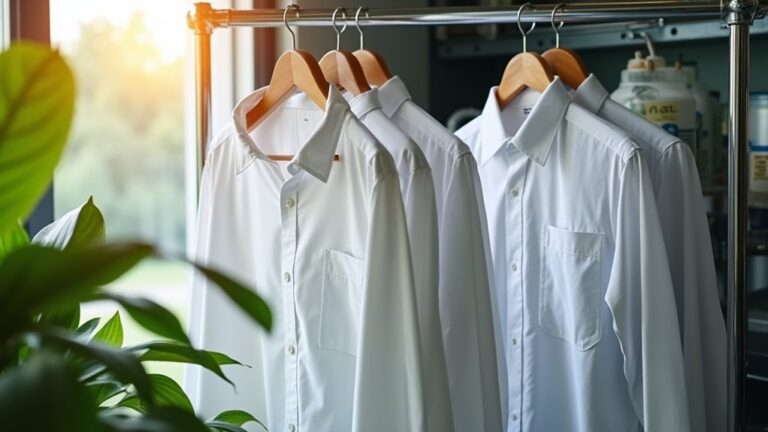You’ll discover six main types of dry cleaning methods when you’re deciding how to care for your precious garments. Traditional perchloroethylene remains the most common choice, while eco-friendly hydrocarbon solvents offer gentler alternatives that won’t leave you worrying about harsh chemicals. Liquid carbon dioxide technology provides zero-waste cleaning, and Green Earth silicone-based systems protect delicate fabrics beautifully. Wet cleaning processes use water-based solutions, and specialty methods handle unique materials like vintage pieces—each approach brings its own advantages worth exploring further.
Traditional Perchloroethylene (Perc) Dry Cleaning
When I first stepped into my neighborhood dry cleaner years ago, clutching a silk blouse stained with what looked like half my lunch, I’d no idea I was about to witness the magic of perchloroethylene in action.
That moment when you discover the chemistry behind rescuing your favorite garments from seemingly impossible stains.
Traditional perchloroethylene (perc) remains the most widely used cleaning agent in the industry, and honestly, for good reason. This chlorinated solvent tackles grease and oil-based stains like a champion, working through fabrics with impressive efficiency.
The dry cleaning process using perc involves careful sorting, pre-treating stubborn spots, the actual chemical cleaning cycle, and meticulous finishing touches.
While perc’s thermal stability and nonflammable nature make it perfect for controlled cleaning machines, you should know that health concerns have prompted many cleaners to explore eco-friendly alternatives. What makes perc particularly effective is its ability to maintain the shape and texture of delicate fabrics while delivering superior cleaning power that water-based methods simply cannot match.
Eco-Friendly Hydrocarbon Solvent Methods
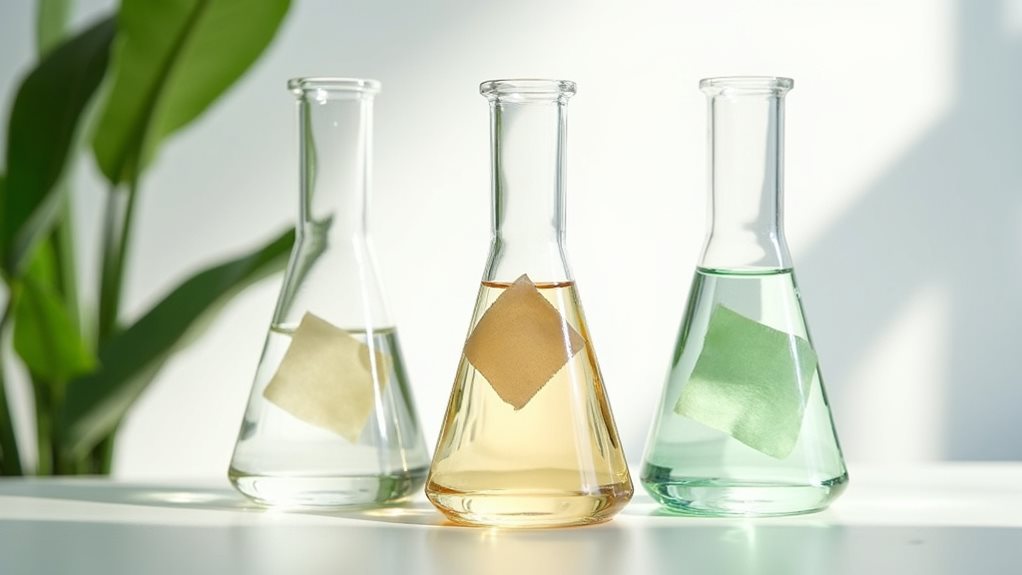
You’ll find that eco-friendly hydrocarbon solvents offer a rejuvenating alternative to traditional perc cleaning, much like choosing organic vegetables over heavily pesticide-treated ones—your clothes get the same thorough cleaning without the harsh chemical aftermath.
These biodegradable solvents work their magic by maintaining your garment’s vibrant colors and soft texture while tackling stubborn stains, all without exposing you, the workers, or Mother Earth to toxic fumes that make everyone cringe.
The best part is that your clothes dry faster and require less energy during the process, which means you’re not just protecting your favorite silk blouse but also doing your wallet and the planet a solid favor. 🌱
For regular garment maintenance between professional cleanings, steam cleaning provides an excellent chemical-free method that uses high-temperature water vapor to refresh fabrics and remove odors naturally.
Hydrocarbon Solvent Benefits
As someone who’s watched countless delicate silk blouses and cashmere sweaters emerge from hydrocarbon dry cleaning looking remarkably fresh and vibrant, I can confidently say these eco-friendly solvents represent a genuine game-changer in fabric care.
You’ll notice your clothes maintain their original brightness and softness, unlike traditional methods that can leave fabrics feeling stiff or faded. The hydrocarbon solvents work gently on delicate materials, preventing shrinkage and distortion that’d make you want to cry 😅.
This cleaning process effectively tackles light to moderate stains while being biodegradable, producing fewer harmful emissions than conventional alternatives.
For environmentally-conscious consumers like yourself, these methods offer peace of mind, knowing you’re choosing sustainable options that protect both your wardrobe and the planet.
Unlike perchloroethylene (perc), hydrocarbon solvents don’t pose the same health and environmental concerns that have driven modern regulations in the dry cleaning industry.
Environmental Impact Reduction
Since making the switch to eco-friendly hydrocarbon solvents in my own dry cleaning routine, I’ve discovered that protecting our planet doesn’t require sacrificing the quality care our favorite garments deserve.
You’ll find that biodegradable solvents work equally as effectively as traditional chemicals, while dramatically reducing harmful VOC emissions that once clouded our air quality.
When you choose eco-friendly dry cleaning, you’re not merely protecting delicate fabrics—you’re safeguarding the health of workers who handle these chemicals daily.
The environmental impact reduction becomes even more meaningful when you realize these gentler solvents maintain your clothes’ brightness and softness better than harsh alternatives.
These modern alternatives to perchloroethylene offer the same superior stain removal capabilities while eliminating the environmental and health concerns associated with traditional dry cleaning chemicals.
It’s honestly invigorating to feel good about both my wardrobe choices and their planetary footprint!
Fabric Care Advantages
When I first discovered eco-friendly hydrocarbon solvents, I honestly didn’t expect them to outperform traditional methods in preserving my most treasured garments, but they’ve consistently surprised me with their gentle yet thorough approach to fabric care.
You’ll notice these eco-friendly hydrocarbon solvent methods work wonders on delicate fabrics like silk and wool, maintaining their original softness and vibrant colors where harsher chemicals would cause fading or damage.
The cleaning process involves biodegradable solvents that penetrate fibers without the aggressive bite of perchloroethylene, making your garments last considerably longer.
What really impressed me was how dry cleaning services using these methods delivered quick drying times while preserving fabric integrity—no more worrying about my favorite cashmere sweater shrinking or losing its luxurious feel! 😊
Unlike traditional perc-based methods that can lead to groundwater contamination and air pollution, these eco-friendly alternatives provide safer options with significantly reduced chemical exposure.
Liquid Carbon Dioxide Cleaning Technology
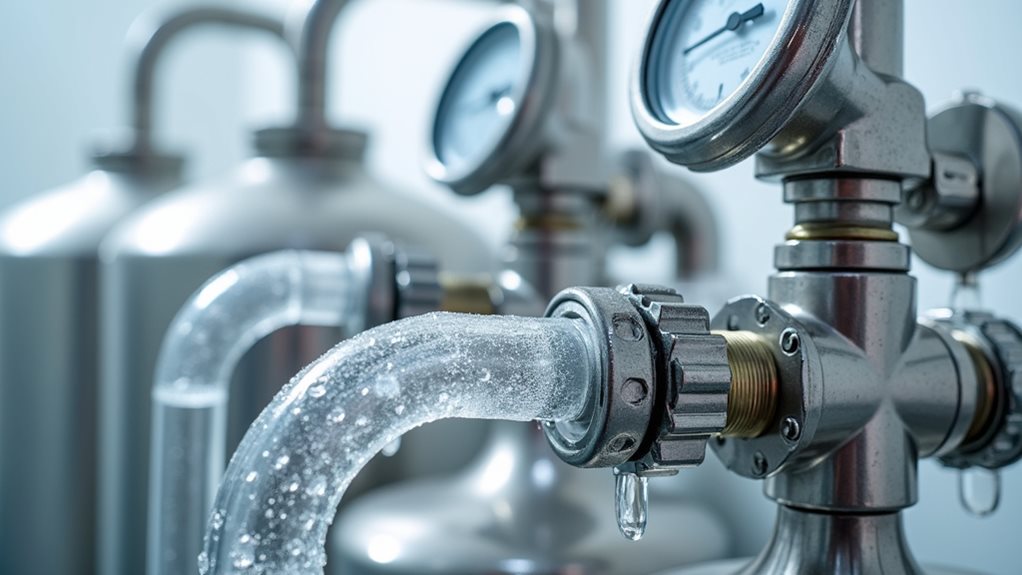
You’ve probably never thought about cleaning your clothes with the same stuff that makes soda fizzy, but liquid carbon dioxide technology represents one of the most innovative approaches in modern garment care.
This fascinating process harnesses supercritical CO2 under high pressure and temperature conditions, creating a powerful yet gentle solvent that penetrates fabrics and dissolves stubborn oils without the harsh chemicals traditional dry cleaning relies on.
While the science might sound intimidating at first, the environmental benefits are invigoratingly straightforward – you’re fundamentally getting spotless clothes while reducing water waste, eliminating toxic solvents, and contributing to a cleaner planet. 🌍
CO2 Cleaning Process
Innovation in the dry cleaning world has brought us liquid carbon dioxide cleaning, a method that’s honestly revolutionized how we think about caring for our delicate garments without harming the planet.
The CO2 cleaning process works by using liquid carbon dioxide as your solvent instead of those harsh chemicals that make you hold your breath when walking past traditional cleaners.
What’s brilliant about this environmentally friendly approach is that it operates at lower temperatures and pressures, so your favorite silk blouse won’t shrink or get damaged.
The liquid CO2 gets recycled during cleaning, which means less waste and fewer toxins floating around.
Professional dry cleaning services using this method can tackle everything from stubborn grease stains to delicate fabrics, giving you peace of mind about both your clothes and the environment.
Unlike traditional perchloroethylene solvents that have raised health and environmental concerns over the years, CO2 cleaning offers a safer alternative for both consumers and dry cleaning workers.
Environmental Benefits Overview
The environmental benefits of liquid CO2 cleaning technology extend far beyond what you might expect from a simple solvent swap, creating ripple effects that touch everything from the air we breathe to the water we drink.
When you choose liquid carbon dioxide cleaning over traditional solvents like perchloroethylene, you’re fundamentally voting for a cleaner planet with every garment.
This innovative process produces zero hazardous waste, dramatically cuts carbon emissions, and operates without consuming precious water resources – something I wish I’d understood better during my own wasteful younger years! 😅
The closed-loop recycling system means the CO2 gets reused repeatedly rather than polluting our environment, proving that effective cleaning doesn’t require ecological sacrifice.
Unlike hydrocarbon-based cleaners that are petroleum-derived, liquid CO2 technology eliminates the environmental concerns associated with fossil fuel extraction and processing.
Green Earth (Silicone-Based) Cleaning Systems
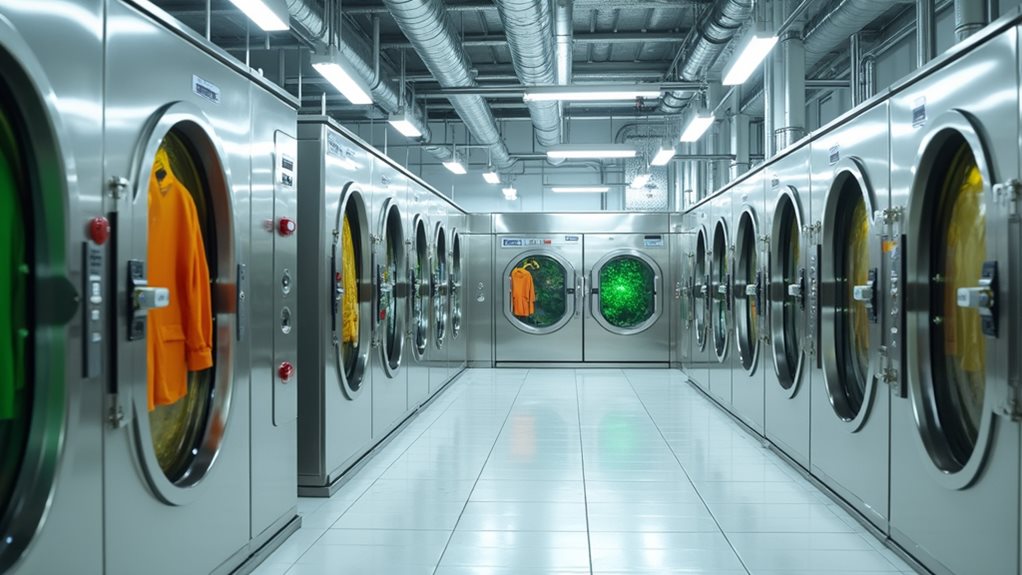
Looking for an eco-friendly dry cleaning option that won’t leave you feeling guilty about your environmental impact? Green Earth cleaning systems might just be your wardrobe’s new best friend!
This innovative method uses decamethylcyclopentasiloxane (D5), a silicone-based solvent that’s as gentle on Mother Nature as it’s on your favorite silk blouse. Unlike traditional harsh chemicals, this eco-friendly approach won’t fade your colors or damage delicate fabrics – I’ve watched countless customers marvel at how fresh their wool sweaters look after treatment.
The closed-loop system recycles the solvent efficiently, minimizing waste while tackling stubborn stains. Plus, you’ll breathe easier knowing there are virtually no harmful emissions floating around. Your clothes get pampered, and the planet stays happy! 🌱
This makes Green Earth a much safer alternative to conventional methods that rely on perchloroethylene, which can cause respiratory issues and contaminate groundwater.
Wet Cleaning Processes for Delicate Fabrics
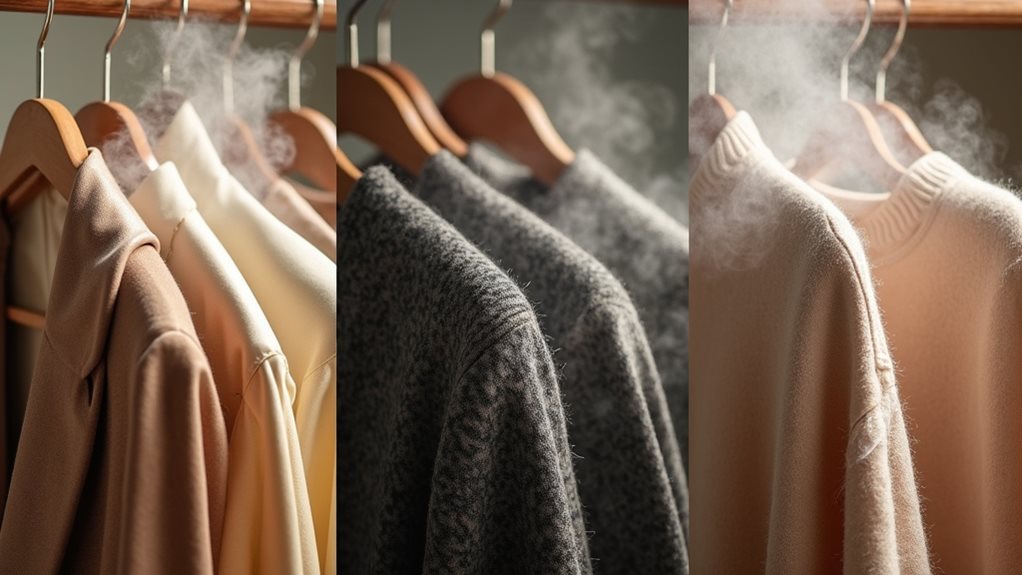
Sometimes you’ll discover that even the most eco-conscious dry cleaning methods aren’t quite right for your most treasured pieces, and that’s where wet cleaning enters the picture like a gentle guardian angel for your wardrobe.
Wet cleaning swoops in as your wardrobe’s gentle savior when even eco-friendly dry cleaning falls short of perfection.
This process uses water and biodegradable detergents to safely clean delicate fabrics like that silk blouse you’re afraid to breathe on wrong, or your grandmother’s wool sweater that holds a lifetime of memories.
The advanced technology regulates temperature and mechanical action precisely, preventing the heartbreak of shrinkage that makes you want to cry into your morning coffee ☕.
Wet cleaning effectively removes stubborn stains while preserving original colors and textures, making it an environmentally friendly choice that protects both your cherished garments and our planet.
Unlike traditional dry cleaning that relies on chemical solvents like perchloroethylene, wet cleaning offers a water-based alternative that’s particularly gentle on sensitive fabrics.
Specialty Cleaning Methods for Unique Materials
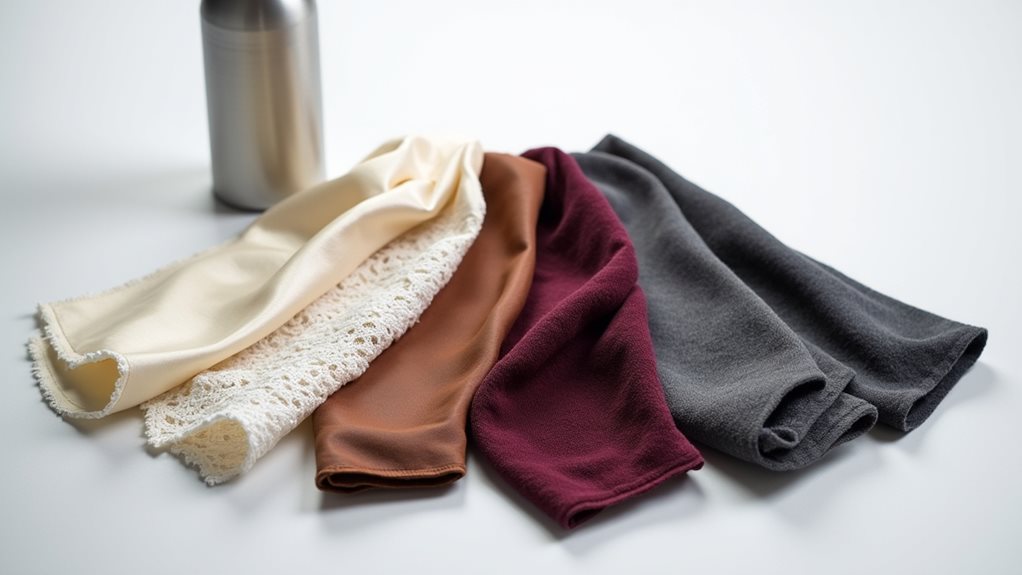
When you’re dealing with wedding gowns or formal attire, these delicate fabrics can’t survive regular cleaning processes.
Professional cleaners use eco-friendly solvents that preserve intricate beadwork while removing stubborn stains.
They’ll assess your vintage pieces carefully, understanding that aging materials react unpredictably to conventional methods.
Sometimes restoration becomes necessary, addressing discoloration or structural damage with patience and expertise.
Unlike water-based washing that can cause shrinkage and color bleeding, chemical solvents safely clean without compromising the fabric’s original structure and appearance.



